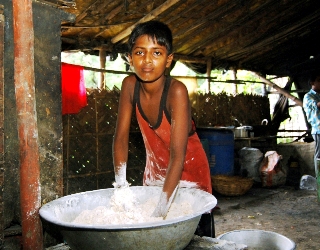 Twelve-year-old Dilip Mondal could never imagine, even in his wildest dreams, of cooking for his family.
Twelve-year-old Dilip Mondal could never imagine, even in his wildest dreams, of cooking for his family.
"Ma is a wonderful cook and Baba and I lapped up whatever she made for us," he said, kneading dough for rumali roti at a roadside dhaba in south Kolkata.
Dilip hails from the Sunderbans. When cyclone Aila struck the area in the summer of 2009, he and his family lost everything and turned paupers overnight.
"We managed to save ourselves by running for our lives and took shelter in a school," Dilip told rediff.com.
He and his family stayed in a relief camp for days and after the water receded, "we went to our home only to discover that there was nothing. Picking up the threads of our life from whatever remained was impossible. The land that we possessed became contaminated with salt water and rendered useless for agriculture."
"Government help was promised but it never reached us. Hence, we decided to move to the city. We were never rich but whatever we earned from cultivating the land was enough for us and it kept us going. However, as soon as we landed in Kolkata, three of us had to take up 'jobs' to keep us going. Baba is working at a mill as a temporary worker, Ma as a housemaid, and I am here."
Dilip makes about Rs 600 a month and gets 4 meals 'free' at the dhaba.
"It's a great help to my parents who don't need to feed me, you see. I don't like this job. I hate to cook. But then, I have to do it for the sake of my parents."
The 12-year-old is a great fan of football and misses his school days at his village.
"I studied till Class V. If our financial situation improves and Baba manages to get himself a permanent job, I would love to go back to school. I want to be an engineer when I grow up. Hard work pays, it is said. And I am sure, my contribution to my family won't be useless."
We pray with him too.
Image: Dilip Mondal. | Photograph: Dipak Chakraborty
Child labour is a dagger through India's soul. The country has the dubious distinction of being home to the largest child labour force in the world, with an estimated 30 per cent of the world's working kids living here.






 © 2025
© 2025